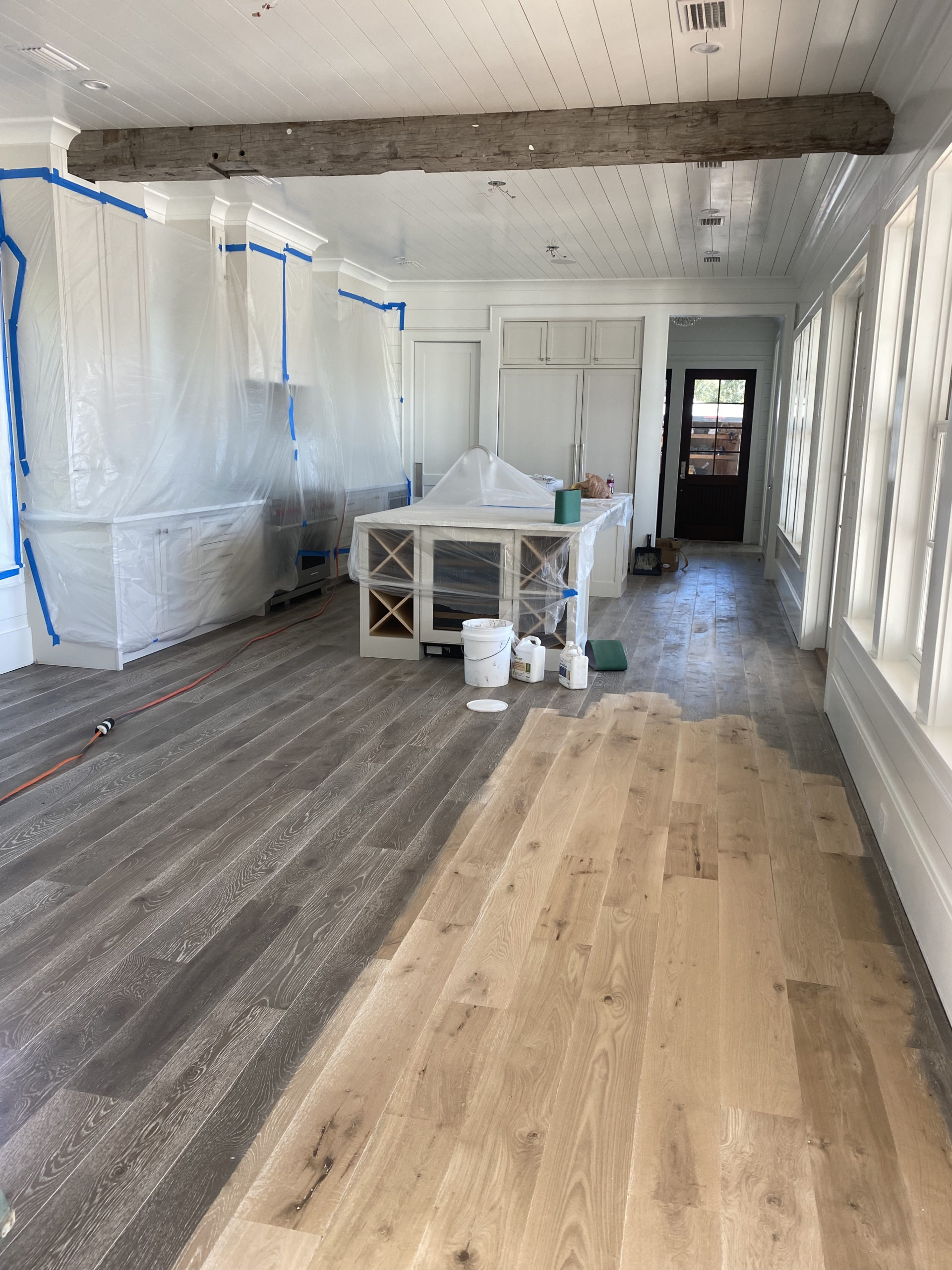Pros & Cons
Let’s first talk about the pros and cons of sanding and refinishing engineered wood flooring so you can decide whether it is a good idea for you or not.
Pros of Sanding and Refinishing Engineered Wood Flooring
- Restores the original beauty: Sanding and refinishing engineered wood flooring can bring back its original beauty and shine. Over time, the surface of the flooring may become worn out or scratched, but sanding can remove these imperfections and reveal a fresh, smooth surface.
- Extends the lifespan: By sanding and refinishing the engineered wood flooring, you can extend its lifespan. This process removes the top layer of the flooring, which may have been damaged or worn down, and allows you to apply a new protective finish. This new finish helps to protect the wood from future damage and can add years to its lifespan.
- Changes the appearance: Sanding and refinishing engineered wood flooring gives you the opportunity to change its appearance. If you are looking for a new look or want to match the flooring to your updated interior design, sanding can remove the existing finish and allow you to apply a new stain or color.
- Increases property value: Refinishing engineered wood flooring can significantly increase the value of your property. By restoring the flooring to its original condition or giving it a fresh, updated look, you can make a positive impression on potential buyers or tenants.
Cons of Sanding and Refinishing Engineered Wood Flooring
- Limited sanding depth: Engineered wood flooring has a limited wear layer, which is the top layer that can be sanded. Sanding too aggressively or repeatedly can wear down this layer and expose the underlying substrate, which may be a lower-quality material.
- Risk of damage: Sanding and refinishing engineered wood flooring can be a delicate process. If not done properly, it can damage the flooring, such as creating uneven surfaces or leaving visible sanding marks. Professional expertise or careful DIY techniques are required to minimize the risk of damage.
- Time-consuming and messy: Sanding and refinishing engineered wood flooring is a time-consuming process. It involves multiple stages, including sanding, applying finishes, and allowing them to dry. Additionally, it can create a lot of dust and debris, requiring thorough cleaning afterwards.
- Costly: Hiring professionals to sand and refinish engineered wood flooring can be costly. The process requires specialized equipment and expertise, which adds to the overall cost. Additionally, if you choose to do it yourself, purchasing or renting the necessary tools can also be expensive.

The Composition of Engineered Wood Flooring and Its Impact on Sanding and Refinishing
The composition of engineered wood flooring plays a crucial role in determining whether it can be sanded and refinished. Engineered wood flooring is made up of multiple layers, typically consisting of a top layer of hardwood veneer and several layers of plywood or high-density fiberboard (HDF) underneath. These layers are bonded together using adhesives and heat.
The top layer of hardwood veneer is what gives engineered wood flooring its aesthetic appeal and durability. This layer is usually made from a thin slice of real hardwood, such as oak or maple. The thickness of this veneer layer can vary, but it generally ranges from 0.6mm to 6mm. The thicker the veneer, the more times the flooring can be sanded and refinished.
The underlying layers of plywood or HDF provide stability and strength to the engineered wood flooring. These layers are typically made from compressed wood fibers and resins. The composition and quality of these layers also play a role in determining whether the flooring can withstand the sanding and refinishing process.
When it comes to sanding and refinishing engineered wood flooring, the thickness of the hardwood veneer is crucial. If the veneer is too thin, sanding can potentially damage or even penetrate through it, exposing the underlying layers. This can lead to irreversible damage and make refinishing impossible. Therefore, it is essential to check the manufacturer’s recommendations regarding the thickness of the veneer and the number of times the flooring can be sanded and refinished.
Additionally, the type of finish applied to the engineered wood flooring can also impact its ability to be sanded and refinished. Some finishes, such as aluminum oxide or UV-cured urethane, are extremely durable and can withstand multiple sanding and refinishing cycles. On the other hand, certain oil-based finishes or wax coatings may require more delicate handling during the sanding and refinishing process.
The composition of engineered wood flooring, particularly the thickness of the hardwood veneer and the type of finish, significantly influences its ability to be sanded and refinished. It is crucial to consider these factors and follow the manufacturer’s guidelines to ensure the longevity and beauty of the flooring.
When and How to Sand and Refinish Engineered Wood Flooring
Engineered wood flooring is a popular choice for homeowners due to its durability and aesthetic appeal. However, over time, even the most well-maintained engineered wood floors can start to show signs of wear and tear. This often leads homeowners to wonder if their engineered wood flooring can be sanded and refinished to restore its original beauty.
The good news is that in most cases, engineered wood flooring can indeed be sanded and refinished. Unlike solid hardwood flooring, which can typically be sanded and refinished multiple times throughout its lifespan, engineered wood flooring has a thinner top layer of hardwood veneer. This top layer can still be sanded down to remove surface imperfections and restore the floor’s smoothness, but it cannot withstand the same depth of sanding as solid hardwood.
Before proceeding with sanding and refinishing, it is important to assess the condition of the engineered wood flooring. Minor scratches and surface wear are generally good candidates for sanding and refinishing, as the process can effectively remove these imperfections. However, deep gouges, warped boards, or excessive wear may require more extensive repairs or even replacement.
The first step in sanding and refinishing engineered wood flooring is to thoroughly clean the floor. Remove any furniture or rugs and sweep or vacuum to remove dirt and debris. Next, use a mild cleaning solution and a damp mop to remove any remaining dirt or stains. Allow the floor to dry completely before proceeding.
When it comes to sanding engineered wood flooring, it is crucial to use the correct equipment and techniques. Unlike solid hardwood, which can be sanded with traditional drum sanders, engineered wood requires a gentler approach. It is recommended to use a random orbital sander with a fine-grit sandpaper to avoid damaging the thin top layer of veneer. Take care to sand evenly and avoid applying too much pressure, as this can result in an uneven finish.
After sanding, it is important to thoroughly clean the floor again to remove any dust or debris. Use a vacuum or a tack cloth to ensure the surface is completely free of particles. Once the floor is clean, it is time to apply the desired finish. Choose a high-quality wood floor finish that is compatible with engineered wood flooring. Apply the finish according to the manufacturer’s instructions, using a clean applicator or brush. Allow the finish to dry completely before walking on the floor or replacing furniture.
Alternative Options for Restoring and Refreshing Engineered Wood Flooring
Engineered wood flooring is a popular choice for homeowners due to its durability and aesthetic appeal. However, over time, even the most well-maintained engineered wood floors can become worn and scratched. While solid hardwood floors can be sanded and refinished multiple times to restore their original beauty, the same cannot always be said for engineered wood flooring.
Unlike solid hardwood, engineered wood flooring consists of a thin layer of real wood veneer on top of several layers of plywood or high-density fiberboard (HDF). This construction makes it more susceptible to damage during the sanding and refinishing process. In some cases, the veneer layer may be too thin to withstand sanding, resulting in irreparable damage to the floor.
However, this does not mean that engineered wood flooring cannot be restored or refreshed. There are alternative options available that can help improve the appearance and extend the lifespan of your engineered wood floors.
One option is to use a wood floor cleaner and polish specifically designed for engineered wood flooring. These products can help remove surface dirt, stains, and scratches, giving your floors a refreshed look. It is important to follow the manufacturer’s instructions when using these products to avoid any potential damage.
Another alternative option is to apply a new coat of finish to your engineered wood floors. This process, known as recoating, involves lightly sanding the surface to create a smooth base and then applying a new layer of finish. Recoating can help restore the shine and protect the wood from further damage. However, it is crucial to note that not all engineered wood floors can be recoated, as it depends on the condition and thickness of the veneer layer.
If your engineered wood floors are severely damaged or worn, you may consider replacing the damaged boards or refinishing the entire floor. This option should be carried out by a professional flooring contractor who has experience working with engineered wood flooring. They will be able to assess the condition of your floors and provide recommendations on the best course of action.
Can You Refinish Engineered Hardwood?
HOME – Houston Hardwood Floor Refinishing at My Hardwood Floor Guy
2024 Hardwood Floor Refinishing Cost Sand, Stain, u0026 Redo
Refinish Engineered Hardwood Floors Hallmark Floors
Can you refinish prefinished floors?
Beginneru0027s Guide To Refinishing Hardwood Flooring u2014 Inner Space
Non-Sandable Floor Refinishing N-Hance Orlando West
Can you refurbish pre-finished hardwood flooring? – Hardwood Floor
Can you Refinish Engineered Hardwood Floors? – Plank and Pillow
Related Posts:
- How Thick Is Engineered Wood Flooring
- Real Wood Flooring In Kitchen
- Wood Floor Kitchen Cabinet Combination Designs
- Solid Wood Floor Repair Kit
- Dark Wood Floor Finishes
- Light Oak Solid Wood Flooring
- Grey Wood Floor In Bathroom
- Pledge Wood Floor Cleaner Spray
- Wide Plank Wood Flooring Cost
- Light Wood Flooring Ideas











